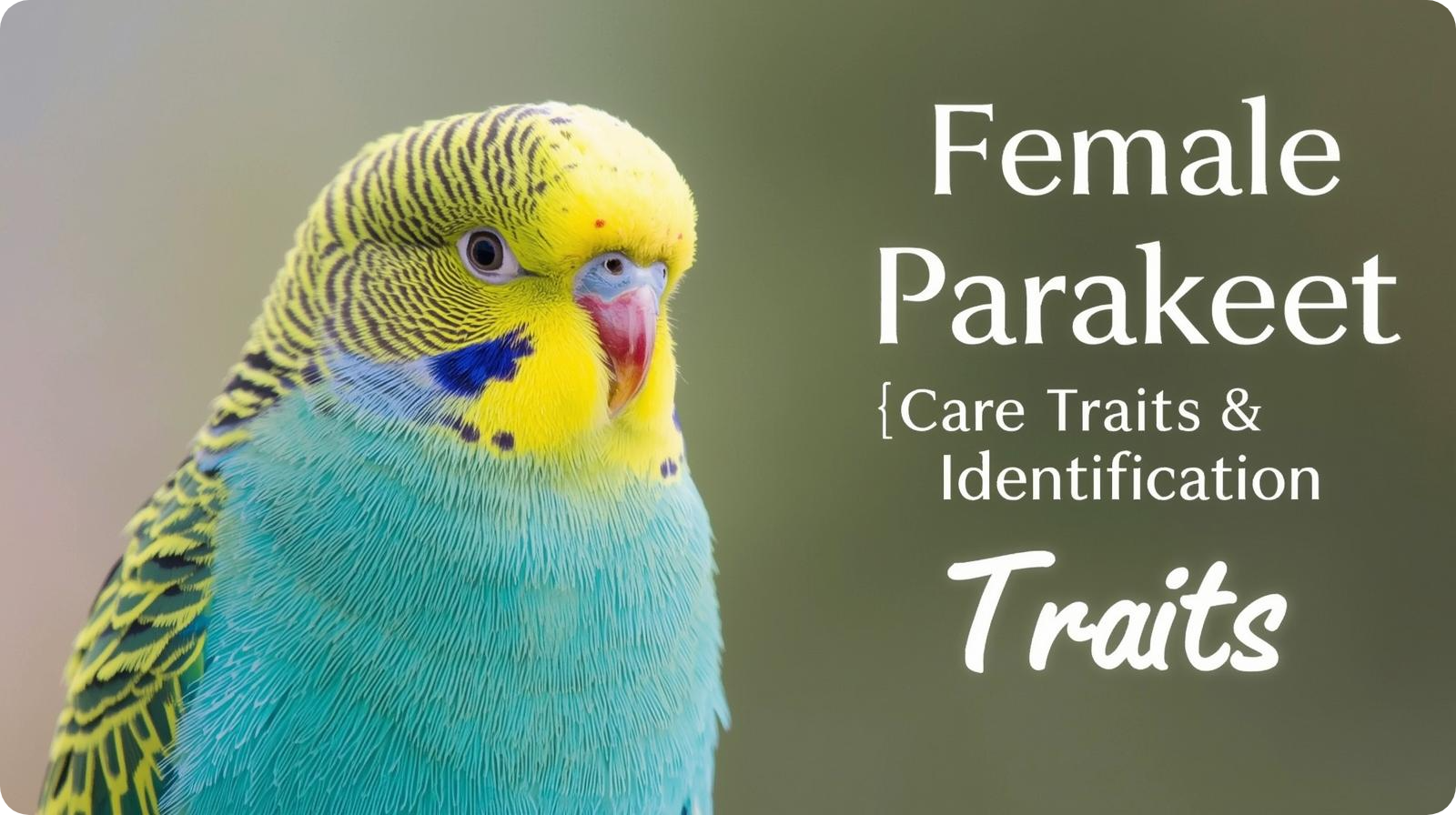

Introduction: Unveiling the World of Female Parakeets
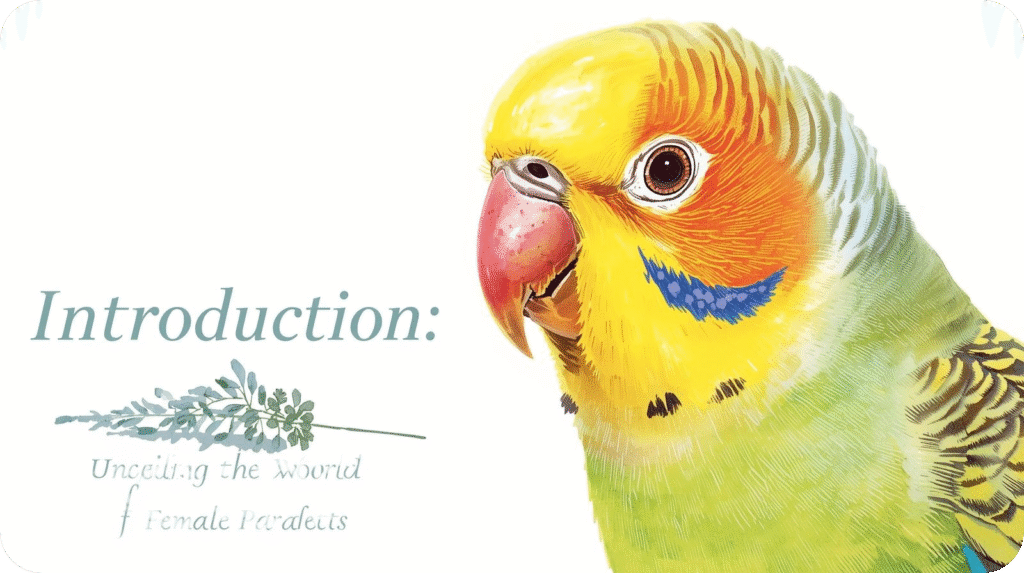
Parakeets, also known as budgerigars, are more than just vibrant companions; they are complex creatures with distinct gender differences. To find out if your parakeet is male or female is the first step. This helps you build a strong bond and give the right care.
Their feathers are bright colors like yellow, green, blue, and white. However, the most important feature is a small, waxy patch above their beak. People call this patch the parakeet cere.
This ultimate guide delves deep into the world of the female parakeet, exploring the color code of her cere and her unique personality traits. You’ll also find a detailed care guide to ensure her long-term health and happiness.
Next, we’ll begin an exciting journey into the science of color and discover how parakeet color mutations occur—a process similar to subtractive color mixing used in painting and printing. By understanding her brown cere and intelligent nature, you’ll be fully prepared to care for your feathered friend.
Mastering Parakeet Gender Identification
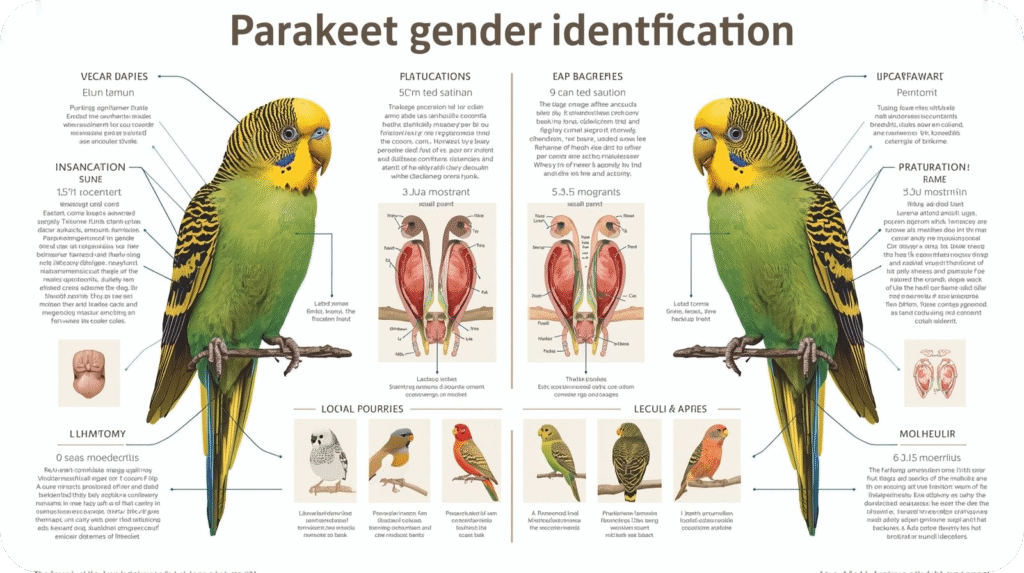
Learning how to tell the gender of parakeets is important for bird owners. This knowledge helps them understand and care for their feathered friends better. While male and female parakeets, also known as budgies, look strikingly similar, subtle differences can reveal their sex.
The best sign is the color of the cere. This is the soft area above the beak where the nostrils are. Males usually have a blue or purplish cere. Females have a brown, beige, or whitish cere, especially during breeding season.
Color changes can happen because of age, mutation, or hormonal shifts. Behavior and vocal sounds can also help. For example, males tend to be more talkative and social. Recognizing these details allows owners to manage their birds more effectively, especially when breeding or pairing them.
In some cases, it can be hard to tell a parakeet’s gender. This is especially true for young birds or color mutations.
These mutations include albino, lutino, or recessive pied varieties. In these cases, the cere color does not follow the usual pattern. For these exceptions, behavioral cues become even more important.
Males are often more playful and social. They like to mimic sounds and whistles.
Females are usually more dominant. They may show territorial behavior, like light nipping or defending their perch. Observing these subtle patterns over time gives a clearer picture of your parakeet’s true identity.
For absolute certainty—particularly for breeders—DNA testing is available and provides a quick, reliable answer. By using both visual observation and scientific proof, parakeet owners can better understand their birds. This helps them care for their pets with confidence.
The Cere: Your Key to Determining a Male or Female Parakeet
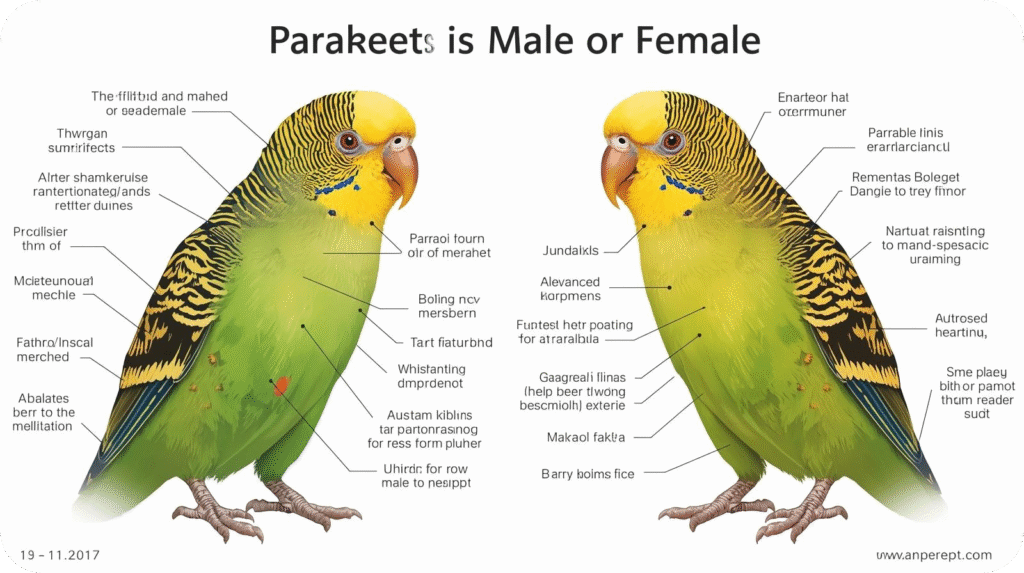
The single most reliable visual indicator of a parakeet’s sex is the cere. This fleshy, bumpy area sits directly above the beak and encompasses the nostrils.
The parakeet cere is a skin layer that responds to hormones. The bird’s sex hormones, mainly estrogen and testosterone, control its color and texture. This creates a natural color code that, once deciphered, removes all guesswork.
It is a common misconception that a parakeet’s feather color indicates its gender. In reality, the bright greens, blues, and yellows come from parakeet color mutations. These colors do not indicate if the bird is male or female. The cere is the only consistent visual marker.
Decoding the Female Cere Color Code
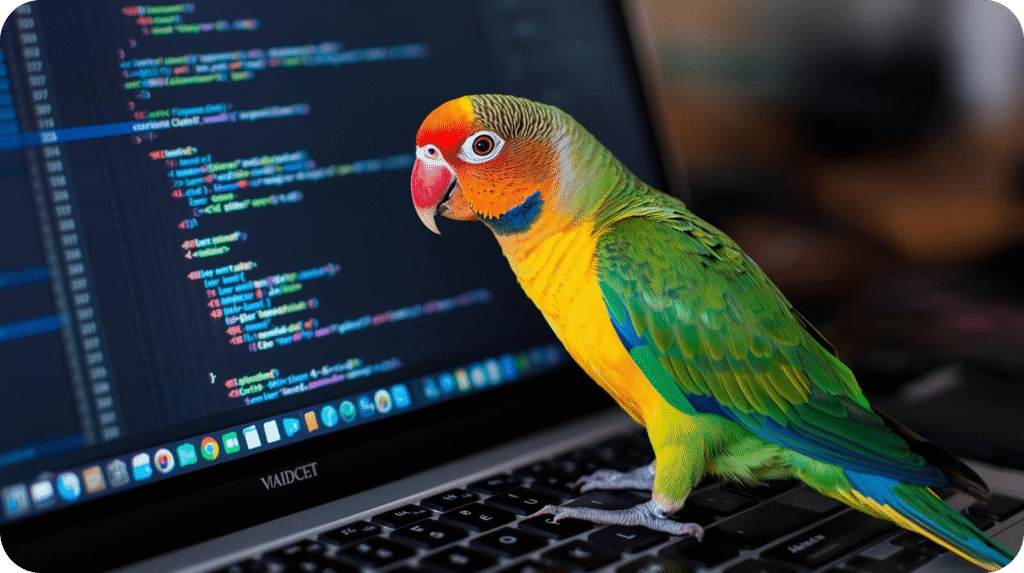
A female parakeet’s cere follows a predictable pattern throughout her life, changing with age, hormonal cycles, and overall health.
The Juvenile Female
Young female parakeets often have a cere that is a light, powdery blue or a soft, whitish pinkish color. The main feature that sets her apart from a young male is her uneven coloring. She has clear white or pale rings around her nostrils.
The Adult Female
As a female parakeet grows up, usually between 8 to 12 months, her cere will change. It will settle into one of two main states:
- Non-Breeding Condition: When not active, an adult female’s cere is usually tan, whitish, or a pale, crusty blue. The texture is often rough, flaky, and crusty. This is normal and healthy. It happens because of keratin buildup and is not a sign of illness.
- In Breeding Condition: When a female is reproductively active, her cere undergoes a dramatic transformation. It becomes a thick, dark brown cere and the crusty texture becomes more pronounced . This is a natural signal that her body is ready for nesting and egg-laying.
Special Cases and Exceptions
Certain parakeet color mutations break the standard rules. For example, Lutino and Albino females usually have a pinkish or beige cere that may not turn brown. In contrast, Recessive Pied females can keep a juvenile-like cere even when they are adults. In these rarer cases, researchers may need behavior or DNA testing for confirmation.
Male vs. Female Cere: A Comparative Table
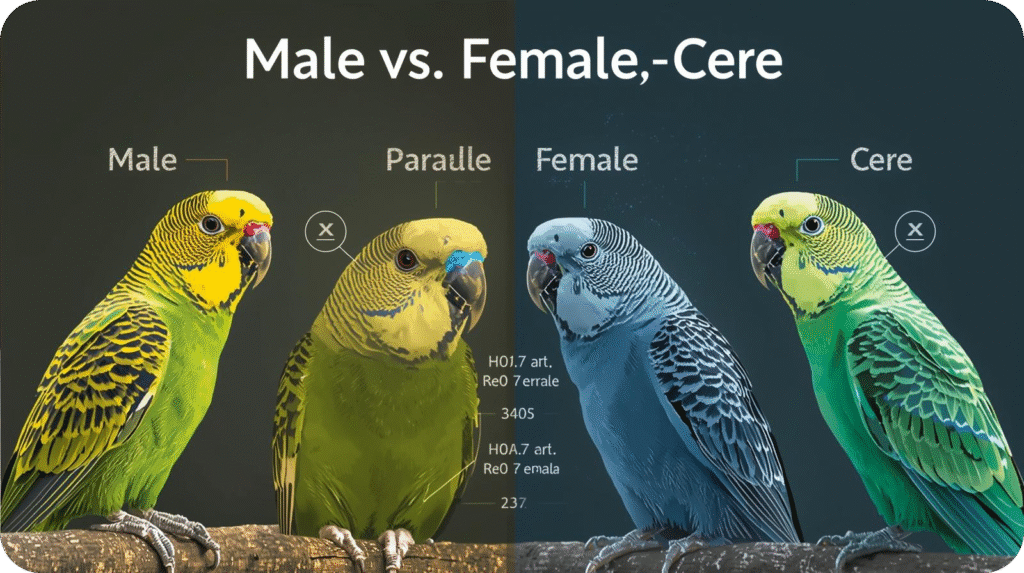
The contrast between male and female ceres is the cornerstone of visual sex identification. The table below provides a clear, at-a-glance comparison.
| Age/Condition of Parakeet | Female Parakeet Cere | Male Parakeet Cere |
|---|---|---|
| Juvenile | Light blue or whitish with white nostril rings. | Uniform pinkish-purple or rosy color. |
| Adult (Normal) | Tan, white, or pale, crusty blue; rough texture. | Solid, vibrant, smooth, royal blue cere. |
| Adult (Hormonal) | Dark brown, very thick, and crusty. | Darker, richer blue; may become slightly thicker. |
| Lutino/Albino | Pinkish, whitish, or beige (may not turn brown). | Bright pinkish-purple (does not turn blue). |
The Science and Art of Female Parakeet Colors
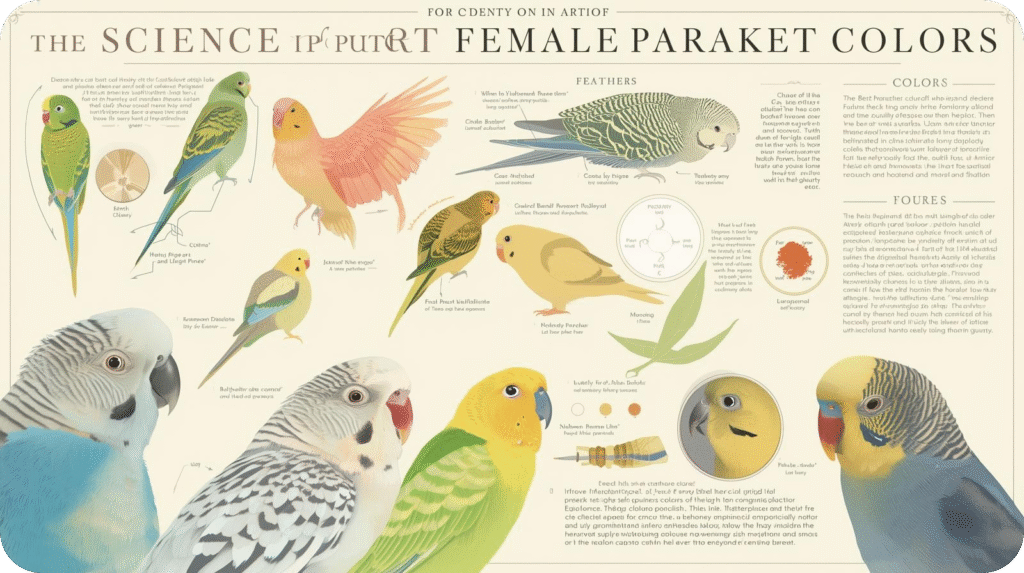
The science and art of parakeet colors is a fascinating interplay between genetics and beauty. Parakeets, also known as budgerigars, come in many colors.
They have bright greens and yellows in the wild. Some have rare shades like violet and blue. There are also albino and lutino types.
The colors come from two main pigments: yellow and blue. These pigments mix in different ways to create the beautiful colors seen in pet birds. The green color of a typical wild parakeet comes from a yellow pigment layer.
This layer sits over a blue reflection. Tiny feather structures bend light and create the blue reflection. When breeders change these pigment expressions through selective breeding, they can create new and beautiful colors. This shows the science behind every shade.
Beyond biology, people undeniably appreciate and cultivate the artistry in parakeet colors. Each color has its own personality. Deep blues bring calmness.
Bright yellows shine with cheer. Pure whites show elegance and rarity. Breeders often treat color selection as a creative pursuit, striving for perfect symmetry between tone, brightness, and feather quality.
Yet, while color captivates human admiration, for parakeets it also serves important natural purposes: attracting mates, signaling maturity, and blending into their environment. Understanding the science of color and the balance of shades helps people see parakeets as more than pets. They are living canvases shaped by both nature and human creativity.
The Two Basic Color Systems in Parakeets
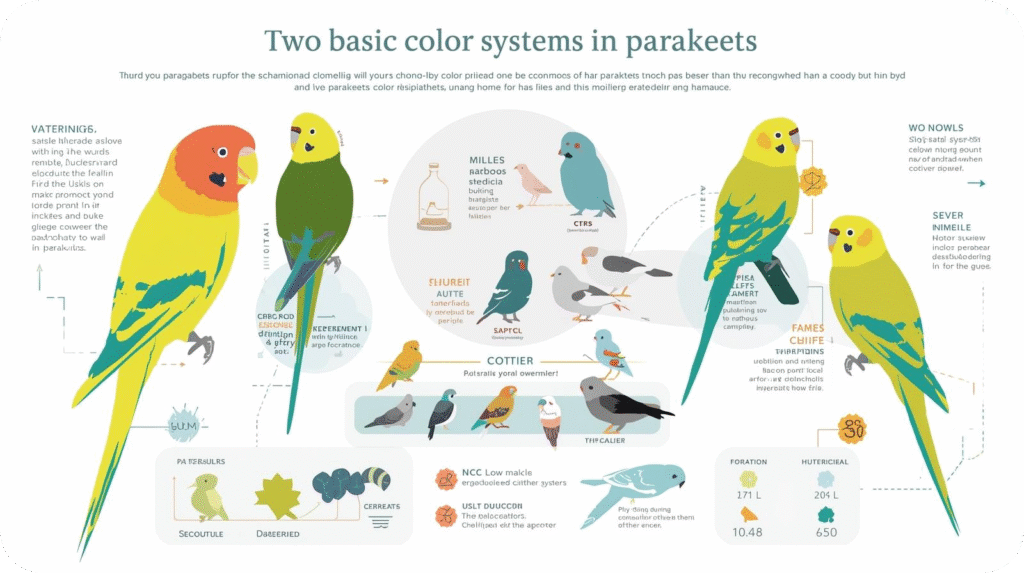
The stunning variety of parakeet colors is a living demonstration of color genetics. All parakeets begin with one of two base pigments, functioning as the basic color foundation:
- Yellow-Based (Green Series): These birds have yellow pigment in their feathers. This is the dominant and original basic color of wild budgerigars.
- White-Based (Blue Series): These birds lack yellow pigment, resulting in a white base .
The color blue cere in males or the blue in a parakeet’s feathers is not a pigment but a structural color. The tiny structure of the feathers scatters white light, creating the effect. This filters out all colors except blue. When this structural blue mixes with the pigment yellow, the result is green—which is why yellow-base birds are typically green .
Understanding Color Models: A Parakeet Perspective

To fully grasp how parakeet colors work, it helps to understand the two fundamental color models. A parakeet’s feathers are a perfect example of the subtractive color model in nature.
- The Subtractive Color Model (CMY): This model, used in paints, inks, and dyes, creates color by subtractive color mixing. Here, pigments create colors by absorbing (subtracting) some wavelengths of white light and reflecting others.
- The primary colors in this model are cyan, magenta, and yellow. When all colors are mixed, they absorb all light and result in black. A parakeet’s feather pigments work in a similar way. They absorb some wavelengths and reflect the reds, blues, yellows, and greens we see.
- The Additive Color Model (RGB) serves as the rgb color model for screens and digital displays. It creates color by adding different light sources together.
- The primary colors are red yellow and blue, or more specifically, red, green, and blue. When you combine all these colored lights at full intensity, they create white light. This is the opposite of how parakeet feathers create color.
A Brief History of Color Theory
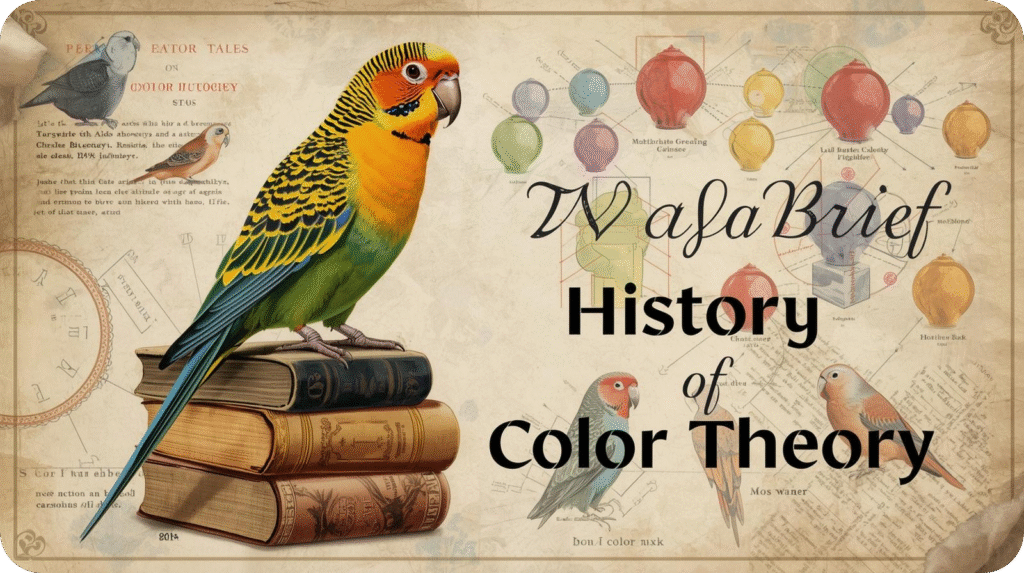
Human understanding of color has evolved over centuries. Sir Isaac newton was a pivotal figure.
In the 17th century, he did famous prism experiments. He demonstrated that white light consists of many colors. He arranged these colors—red, orange, yellow, green, blue, indigo, violet—into a circle. This created the first color wheel.
This color wheel is the foundation of modern color theory. It organizes colors logically, showing the relationship between primary color, secondary colors (created by mixing two primaries), and tertiary colors. This systematic color system helps us understand concepts like complementary colors and harmonious color schemes .
You can understand the colors of a parakeet using these principles. Its body is yellow and green, and it has violet cheek patches.
The Female Parakeet Personality and Behavior

The female parakeet has a personality that’s both captivating and complex. She’s often more independent and cautious than her male counterpart, taking time to observe her surroundings before engaging
. Female parakeets are natural problem-solvers and can be quite assertive, especially when protecting their territory or favorite perch. Males usually talk more than females. Females use shorter, sharper chirps that show their serious attitude.
During breeding season, her behavior changes. She becomes more focused and determined. She may start shredding paper, rearranging her cage, or showing a strong nesting instinct.
Female parakeets are bold, but they can form strong, loving bonds with their owners once they trust them. They enjoy gentle interaction but like to feel in control. They often choose when to play or rest.
Their intelligence shines through in how quickly they learn routines and recognize people. Understanding a female parakeet’s temperament helps owners create a better environment. This includes giving her space, mental stimulation, and respecting her boundaries.
With patience and care, her lively personality becomes a loyal friend. She rewards attention with charm, wit, and strong character.
Core Personality Traits of the Female Budgie
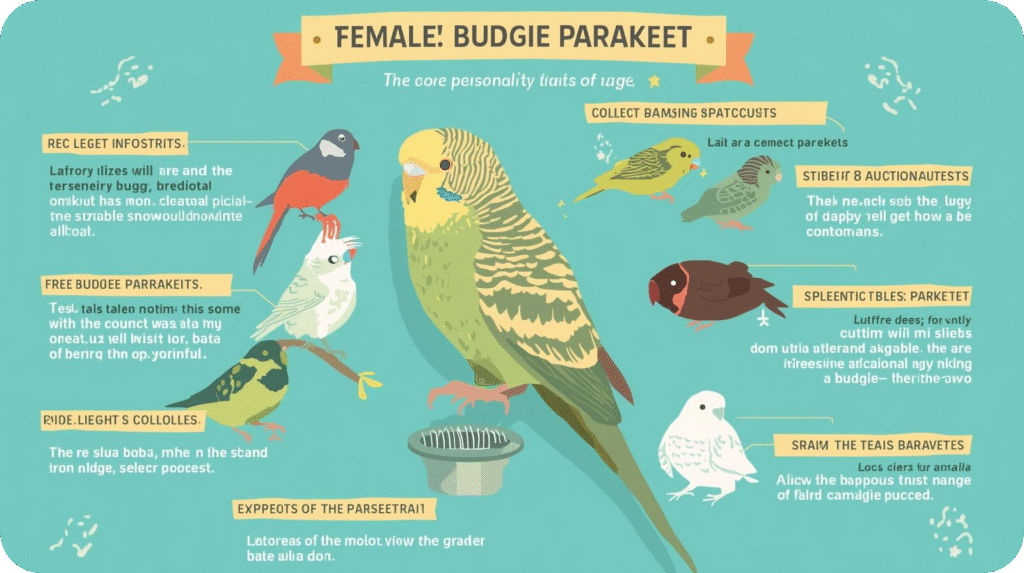
People often describe the female parakeet as the “boss” of the budgie world. Her behavior is deeply rooted in her natural instincts.
In the wild, the female chooses and prepares the nest. She also defends it strongly from intruders. This biological programming shapes her personality in captivity.
- Assertive and Bossy: Females are confident and know what they want. They often dictate access to food, toys, and perches, and they may push other birds away from resources.
- Territorial Instincts: This is one of her most defining traits. A female parakeet often views her cage as her nest territory. If someone invades her space, she may lunge, nip, or emit a distinctive, harsh “chattering” sound. This is not unprovoked aggression but a natural, protective behavior.
- Smart and Destructive: Females are good at solving problems. They have a strong urge to chew and shred. This behavior comes from their instinct to make a nesting space. You should provide appropriate outlets for this behavior; doing so is essential.
- Selectively Affectionate: She may seem more distant and independent than a male at first. However, a patient owner will gain a loyal and trusting friend. Her trust is hard-won but priceless.
Bonding and Training Your Female Parakeet
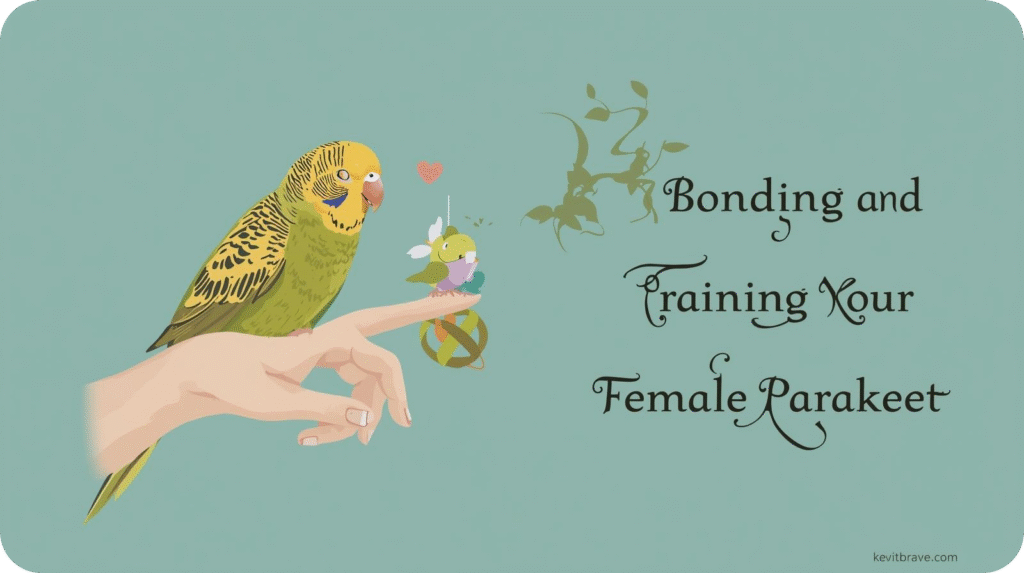
To build a strong bond with a female parakeet, you need patience and respect for her independence.
- Respect Her Boundaries: Never force interaction. Let her approach you on her terms. If she seems irritable or hormonal, giving her space is the fastest way to build trust.
- Use Positive Reinforcement: Offer high-value treats like spray millet from your hand. Speak to her in a soft, calm voice daily.
- Engage Her Intelligence: Provide foraging toys and puzzles that make her work for her food. This engages her brilliant mind and prevents boredom.
- Consistency is Key: Short, daily training sessions for “step-up” commands are more effective than long, sporadic ones.
Comprehensive Care and Health Guide for Female Parakeet
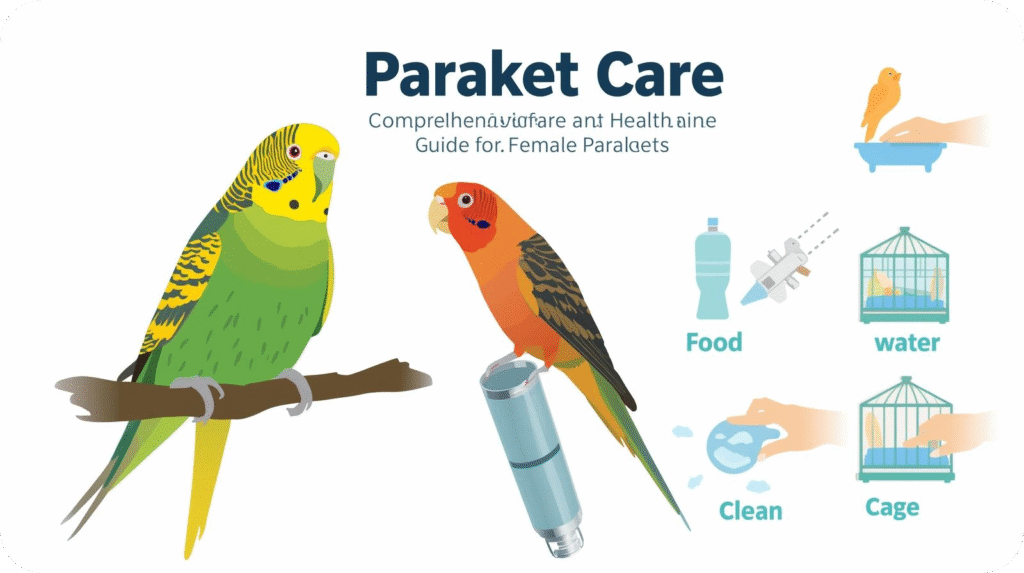
Comprehensive care and health management are the foundation of a happy, long-lived parakeet. These lively birds thrive in environments that balance cleanliness, nutrition, mental stimulation, and affection.
A large cage with horizontal bars for climbing is important. It should have many toys for fun. Daily out-of-cage exercise keeps them active and stops boredom-related stress.
A balanced diet should have good seeds or pellets. It should also include fresh fruits and vegetables like spinach, carrots, apples, and broccoli. Always provide clean, fresh water, and wash food bowls daily to avoid bacterial buildup.
Parakeets are very social birds. They need companionship to stay happy. This can come from another bird or regular time with their human caregiver.
Health monitoring is equally vital. A healthy parakeet has bright eyes, smooth feathers, steady breathing, and lively behavior.
Do not ignore warning signs like ruffled feathers, loss of appetite, wheezing, or changes in droppings. These signs may mean your pet is sick.
It is a good idea to have regular check-ups with a bird vet. This helps find problems early and keeps vaccinations current.
Keeping good hygiene is important. Clean the cage every week. Make sure it is in a well-lit area that is free from drafts. This helps prevent respiratory and parasitic problems.
With regular care, good food, and a fun environment, parakeets can live for more than ten years. They bring their owners lots of color, charm, and friendship.
Creating the Optimal Habitat

A proper environment is crucial for your female parakeet’s long term well-being. Her cage is her territory, so it must be both spacious and stimulating.
- Cage Size and Setup: The smallest cage for one bird is 18″ L x 18″ W x 18″ H. However, a larger cage is always better. The cage should be wider than it is tall to accommodate horizontal flight. Place it in a socially active area of your home, but away from direct sunlight, drafts, and kitchens.
- Interior Design: Provide a variety of perch diameters and textures to ensure foot health. Most importantly, fill the cage with shreddable toys. Use bird-safe wood blocks, sola wood, seagrass mats, and paper toys. These will satisfy her natural chewing instincts.
Nutrition: The Foundation of Health
A balanced diet is your first line of defense against common health issues.
- Staple Diet: A high-quality pellet should form 60-70% of her diet, providing balanced nutrition.
- Fresh Foods: Offer daily fresh vegetables, particularly dark leafy greens, broccoli, and carrots.
- Calcium is Critical: For females, calcium is non-negotiable. A deficiency can lead to egg-binding, a life-threatening common health issue. Always have a cuttlebone or mineral block available in the cage .
Health Tips: Prevention and Early Detection for Female Parakeet
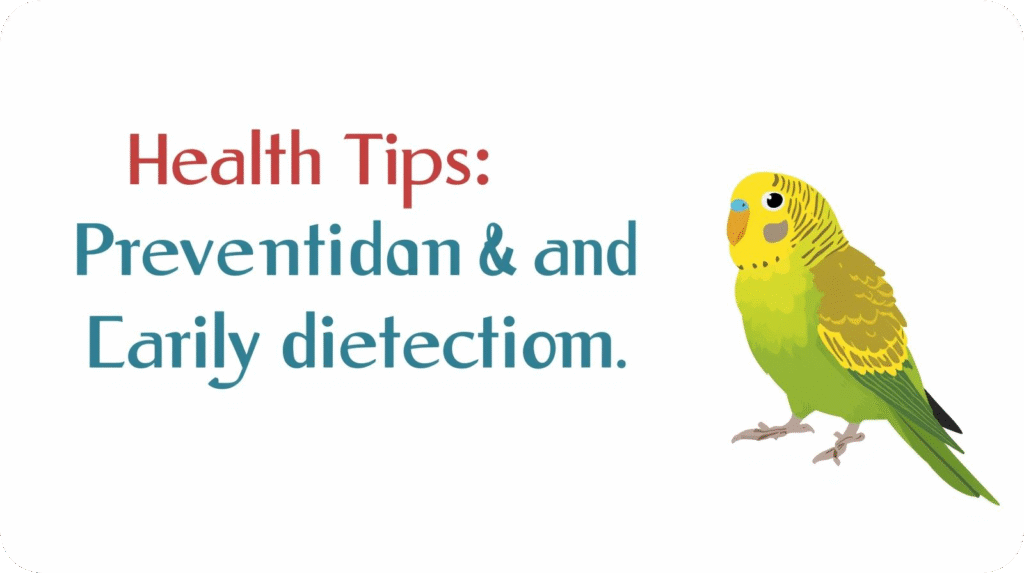
Vigilance is key to a healthy bird. Here are essential health tips for every owner:
- Monitor the cere: A brown cere is normal, but watch for signs of infection. Look for redness, swelling, or discharge. A cere that is an abnormal color, like a sickly yellow-green, can also indicate illness in males .
- Prevent Egg-Binding: This is a critical common health issue where an egg gets stuck in the oviduct. Ensure a calcium-rich diet and be aware of symptoms: straining, lethargy, fluffed-up feathers, and a swollen abdomen. This is a veterinary emergency.
- Encourage Physical Activity: Regular, supervised flight time outside the cage is vital for mental stimulation and physical activity, helping to prevent obesity and boredom.
- Schedule Yearly Vet Check-ups: Having a good relationship with an avian vet is important. It helps with prevention and early diagnosis of problems.
Table: Common Health Issues in Female Parakeets
| Health Issue | Symptoms | Prevention & Action |
|---|---|---|
| Egg Binding | Straining, sitting on cage floor, lethargy, swollen abdomen, fluffed-up feathers. | Prevention: Provide constant calcium (cuttlebone). Action: This is a VETERINARY EMERGENCY. |
| Chronic Egg Laying | Laying repeated clutches of eggs without a mate; can lead to weight loss, weakness, and calcium depletion. | Limit daylight hours, remove nesting sites/materials, and rearrange the cage frequently. Consult a vet for dietary and hormonal management. |
| Scaly Face Mites | Crusty, honeycomb-like growths around the cere, beak, and eyes. Can lead to beak deformities. | Action: Requires prescription medication from an avian vet. Isolate infected birds and thoroughly clean the cage. |
| Obesity | Overweight, lethargy, difficulty flying, labored breathing. | Provide a balanced pellet-based diet, limit high-fat seeds, and encourage daily exercis |
Frequently Asked Questions (FAQs)
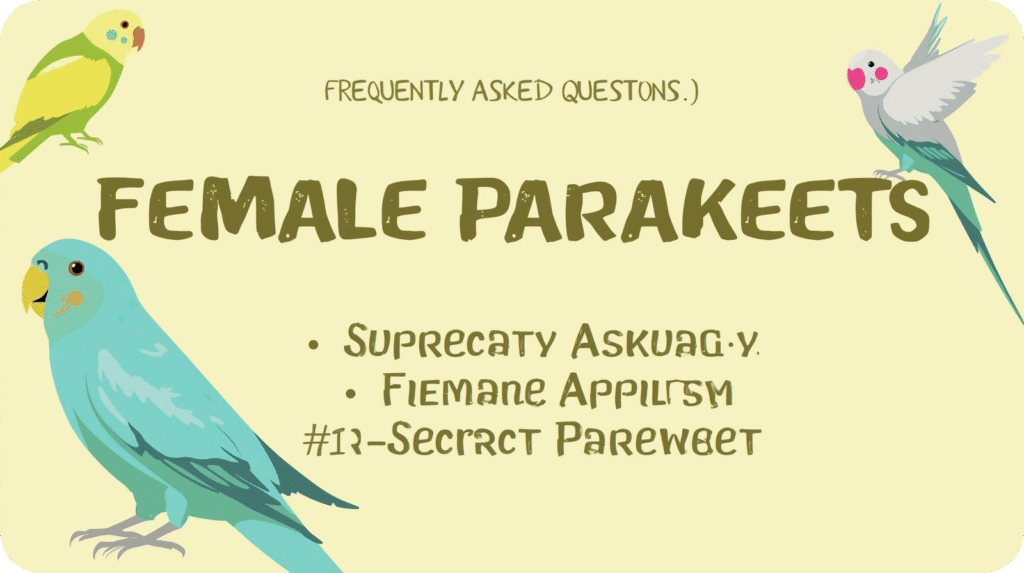
1. How can I tell if my parakeet is male or female?
The most reliable way is to look at the color and texture of the cere (the fleshy area above the beak).
- Males typically have a solid, vibrant blue or purplish-pink cere that is smooth and waxy.
- Females usually have a cere that is tan, whitish, pale blue, or brown, and it often becomes rough and crusty in adulthood. Juvenile females often have a light blue cere with distinct white rings around the nostrils.
2. My female parakeet’s cere is turning brown and crusty. Is she sick?
No, this is completely normal and a sign of good health! A dark brown, thick, and crusty cere indicates that your female is hormonally active and in “breeding condition.” It is a natural signal that her body is ready for nesting and egg-laying.
3. What is egg-binding, and why is it an emergency?
Egg-binding is a life-threatening condition where a female parakeet is unable to pass an egg that is stuck in her oviduct. Symptoms include straining, lethargy, fluffed-up feathers, and a swollen abdomen. It is a veterinary emergency that requires immediate professional intervention. Ensuring a constant supply of calcium (via a cuttlebone) is a key preventive measure.
4. Are female parakeets less friendly than males?
They are not less friendly, but they are often more independent and territorial. Females can be assertive, “bossy,” and more selective about affection. However, with patience and respect for their boundaries, they form incredibly strong, loyal, and deeply trusting bonds with their owners.
5. My Lutino (yellow/red-eyed) parakeet has a pink cere. Is it male or female?
For Lutino and Albino parakeets, the standard cere color rules do not apply.
- Males will have a bright, pinkish-purple cere for their entire lives.
- Females will have a cere that is pinkish, whitish, or beige, and it typically will not turn the dark brown of a normal female, even when hormonal. In these cases, behavior (like territorial chattering) is a better indicator of gender.
6. Why does my female parakeet shred everything in her cage?
This is a completely natural and healthy behavior! Female parakeets have a strong instinct to chew and shred to prepare a nesting cavity in the wild. Providing safe, shreddable toys (made of bird-safe wood, seagrass, and paper) is essential to satisfy this instinct and keep her mentally stimulated.
7. What should I do if my female is laying too many eggs?
Chronic egg-laying can deplete her calcium and nutrient reserves. To discourage it:
- Limit daylight hours to 8-10 hours to simulate a non-breeding season.
- Remove any nesting sites or enclosed, dark spaces.
- Frequently rearrange her cage to disrupt her territorial feelings.
- Consult an avian vet for further advice, which may include dietary adjustments or hormone therapy.
8. How does the color of a parakeet’s feathers relate to its gender?
It doesn’t. A parakeet’s vibrant feather colors are the result of genetic color mutations and have no bearing on whether it is male or female. The cere color is the only consistent visual gender indicator, not the feather color.
Conclusion: Celebrating Your Female Parakeet
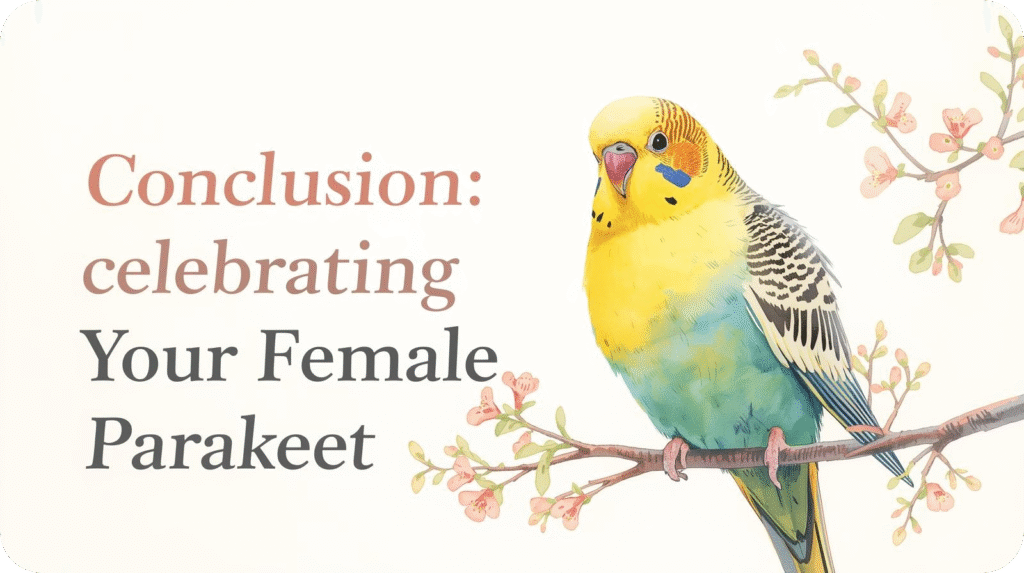
The female parakeet is a creature of remarkable intelligence, fierce independence, and profound loyalty. While she may be more challenging at first than a male, earning her trust is very rewarding in aviculture. – Understand her unique fur color.
– Respect her strong personality.
– Provide the care she needs.
By doing these things, you are more than just keeping a pet. You are building a deep and meaningful bond between species.
Her bossy chirps and careful shredding of toys show her wild ancestry. Embrace her quirks, celebrate her strengths, and provide her with a safe, enriching, and loving home.
Your female parakeet will give you a special kind of friendship based on respect. She will be a feathered friend. Once she trusts you, it is a true and lasting gift.

Leave a Reply